It looks like you can throw out most of what I wrote last Friday. I was
expecting a deeper market correction after most market indexes broke
short-term head and shoulder "necklines" (and daily EMA lines turned
negative). I also wrote about the possible threat from a rally in the
CBOE Volatility (VIX) Index. It turns out I was wrong on both counts. Stocks rallied strongly and the VIX touched a new low.
Although some readers have asked if the current rally could be just
another "right shoulder", I'm somewhat doubtful. A retest of the June
high at 956 looks more likely. The fact that the technology-dominated
Nasdaq market has already exceeded that high is also influencing a
rising market. That doesn't rule out the possibility for a market
correction later in the summer or the autumn. This week's upturn,
however, has postponed that possibility for the time being.
I also wrote that a dollar rally would most likely coincide with a stock
pullback. The reverse happened. The dollar dropped as most foreign
currencies rose (except for the yen). Chart 1 shows the Euro bouncing
off chart support near 137.5 and its 50-day moving average. The Euro
has the biggest influence on the dollar. The Euro has also had a
positive correlation to stocks since March. The week's bounce kept its
March uptrend intact which helped stocks as well. The Japanese yen
(which rallied the previous week on safe haven buying) pulled back this
week as stocks bounced. Chart 2 shows the XJY retesting its neckline
near 106. A close back below that support line would be positive for
stocks.
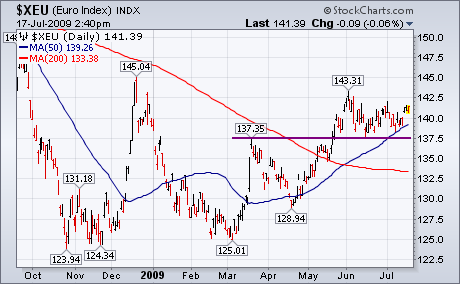
Chart 1
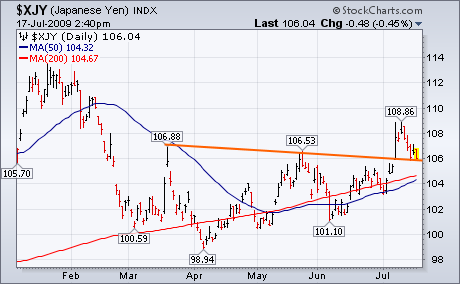
Chart 2
It is hard to argue with the bulls when the vast majority of Nasdaq and NYSE stocks are trading above their 200-day SMAs. Over 66% of Nasdaq stocks are trading above their 200-day moving averages, while over 77% of NYSE stocks are trading above their 200-day moving averages. There are two important parts to this indicator: absolute level and direction. Despite some stalling over the last 6 weeks, the overall direction is up for both breadth indicators. There have been pullbacks along the way, but the overall trend since late March is up. The bulls are in control as long as this uptrend holds.
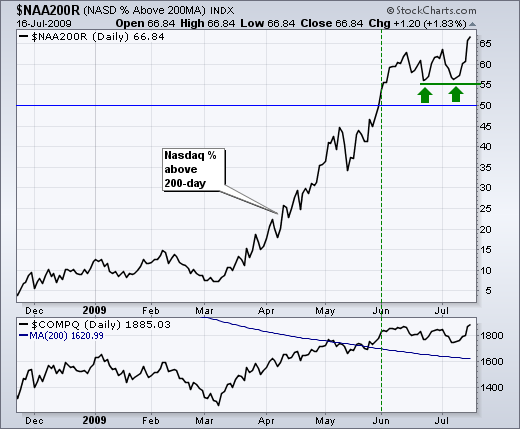
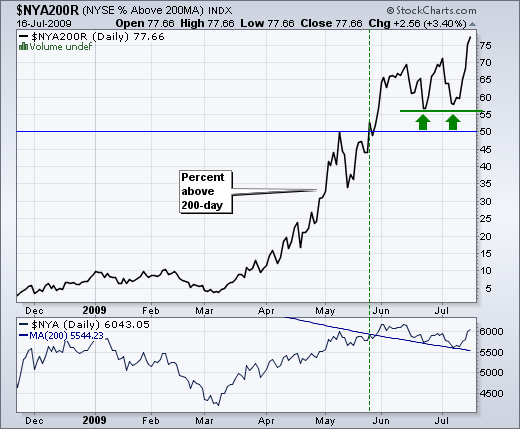
Both indicators moved above the critical 50% threshold at the end of May. There was some market weakness in late June and early July, but the moving average percents held above 55%. In fact, both established support at 55% with bounces in late June and early July (green arrows). This looks like an important support level for the indicator. The bulls are in good shape as long as both hold above 55%. A move below this support would argue for a correction or consolidation period in the market.
Last week I presented an alternate scenario to the head and shoulders breakdown and projected decline:
"While the bearish case seems strongest at this point, a bullish
outcome is not impossible. Bullish forces have weakened, but it is not
at all clear that the bear market has resumed. A more positive analysis
of the situation could be that there has been a two-month rally from
the March lows, followed by a two-month correction/consolidation. The
neckline violation could be the end of the correction and a bear trap.
I present this outcome because I have seen it happen before, and it is
not yet out of reach; however, I don't think it is likely."
Well, I didn't think it was likely, but that is what happened. I don't
feel too bad about that because our Thrust/Trend Model is still on a
medium-term buy signal, proving once again that the timing model is
smarter than I am. But being wrong can also impart useful information.
Since the bearish formation ultimately resolved in a bullish direction,
we can assume that bullish forces are in command, and that the rally
will continue.
So now, with the head and shoulders pattern having evaporated,
we need to attempt to apply another context to the price pattern. The
most obvious at this point is that the decline from the June top was a
correction/consolidation for the advance off the March lows. I have
drawn lines to define the top and bottom of the declining trend
channel, which looks a lot like a flag formation hung on a lazy flag
pole. There has been a strong breakout above the top of the channel.
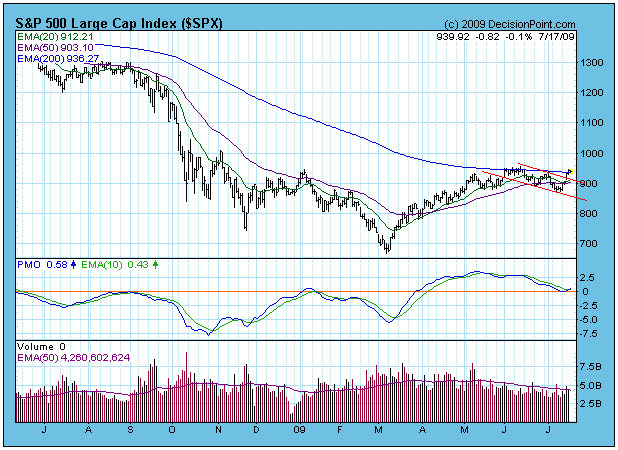
The concern at this point, "Is the breakout really just a blowoff?" The
June top has not yet been exceeded, volume on the breakout was
unimpressive, and short-term indicators are very overbought. Below is a
chart of the CVI (Climactic Volume Indicator) and STVO (Short-Term
Volume Oscillator). Both have reached climactic levels, but as usual we
are left to decide if it is an initiation climax or an exhaustion
climax (blowoff). My opinion is that it is an initiation climax,
because it has occurred after a price consolidation, rather than at the
top of an advance. Also, most medium-term indicators are not
overbought.
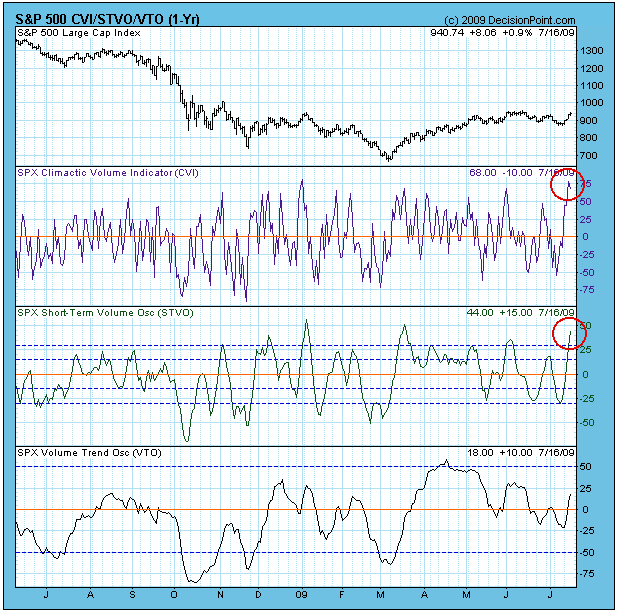
Using flag pole as a measuring stick, I estimate a possible upside
price target of 1200. Assuming that price is in the ball park, our
long-term model, which is still bearish, will be switching to bullish
very soon. Until then, I will still assume that the long-term is
bearish, but I thought it worthwhile to point out that we are nearing a
tipping point.
Bottom Line: The violation of the head and shoulders neckline
has proven to be a bear trap, and my opinion is that the rally from the
March lows is resuming. My upside price target is about 1200 on the
S&P 500. I have to say that this doesn't make any sense considering
what I think I know about the economy, which is why I try to ignore
fundamentals in favor of the charts.
This first chart really says it all:
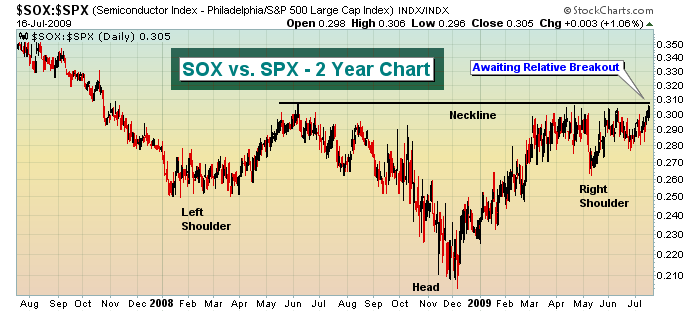
Semiconductors are trying to break out on a relative basis. They're trying to do it at a time when the major indices are attempting breakouts of their own. A combination of a relative price breakout in semiconductors while at the same time breaking out across our major indices would be very bullish for equities, arguing for much higher prices. Will the breakouts occur? Tough question. We'll need a catalyst. Intel Corp (INTC) provided the boost necessary to jumpstart the SOX and send it to test previous highs. The chart below shows us the nice price action in the semiconductor group over the past several trading sessions:
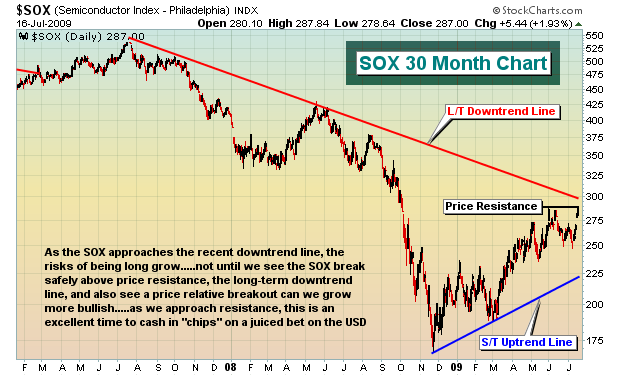
The USD tracks the Dow Jones U.S. Semiconductor Index (DJUSSC) at a 200% clip. The DJUSSC was up 16.74% from the low on July 8th to the high on July 16th. The USD, designed to double those returns, posted gains of 35.69%. That was actually slightly more than double. It's the beauty of compounding returns. Anytime you can identify a trend in an index, playing that trend with juiced ETFs makes perfect sense so long as you understand the leveraging nature of the beast. When underlying indexes are in trendless periods, moving back and forth, these juiced ETFs are DEADLY. The only time you want to hold juiced ETFs is when the trend is moving in the direction you're looking for. When the trend stops, you must move to the sidelines.
On Wednesday, July 22nd, at 4:30pm EST, my partner John Hopkins and I will be having a LIVE webinar specifically designed to uncover the secrets of successfully trading juiced ETFs. It is a FREE webinar. We'll spend plenty of time detailing when you want in and when you want out of these highly volatile ETFs. The longer you hold, the more "slippage" you'll experience as the juiced ETFs are specifically designed to follow at a 200% clip so long as a trend is in place. Once the trend changes, all bets are off. If you'd like to register for this FREE event, click here.
The bulls have been in charge since the March lows. Specifically, the NASDAQ has barely cleared a key 38.2% Fibonacci retracement level from the October 2007 high down to the March 2009 low and is now approaching significant gap and price resistance levels as illustrated below:
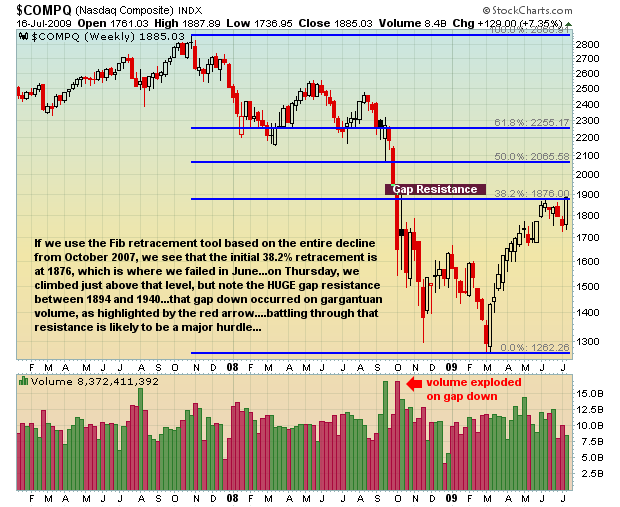
It is going to be very interesting to see whether the bulls can maintain control of the market as we enter into the worst period of the year historically (mid-July through late September).
Happy trading!
As the summer doldrums set in, we've seen quite a bit of back and forth in the various capital markets, with prices not moving far from where they were just 2-months prior. However, last week was important for the Gold Miners (GDX) we believe, for a very simple, yet elegant weekly "key reversal" higher has formed. Moreover, this pattern occurred from the 60-week moving average, which in the past has provided reasonable resistance and support. However, the 14-week stochastic has yet to turn up in confirmation; but we would expect it to do so from roughly neutral levels - which would posit that GDX will trade from its current $38.64 level upwards towards $45-to-$57.50.
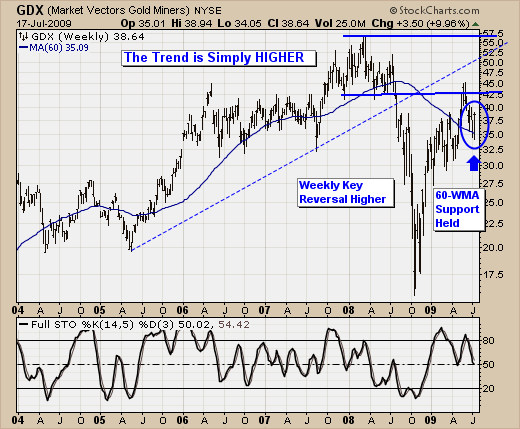
As an aside from this chart, we'll further note that the daily Gold Miners/S&P 500 Ratio (GDX/SPY) is forming a rather bullish pennant pattern, which if comes to fruition would suggest that GDX will outperform SPY by roughly 2-to1 in the months and year ahead.
Thus, given the mixture, we are clearly constructive on the Gold Miners, and would certainly consider being long at current levels. Our risk point would be a bit more than -10% lower to $34.
Good luck and good trading,
Richard